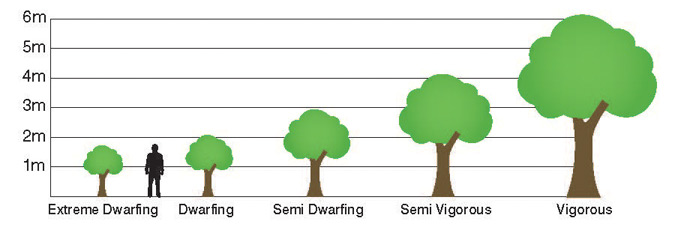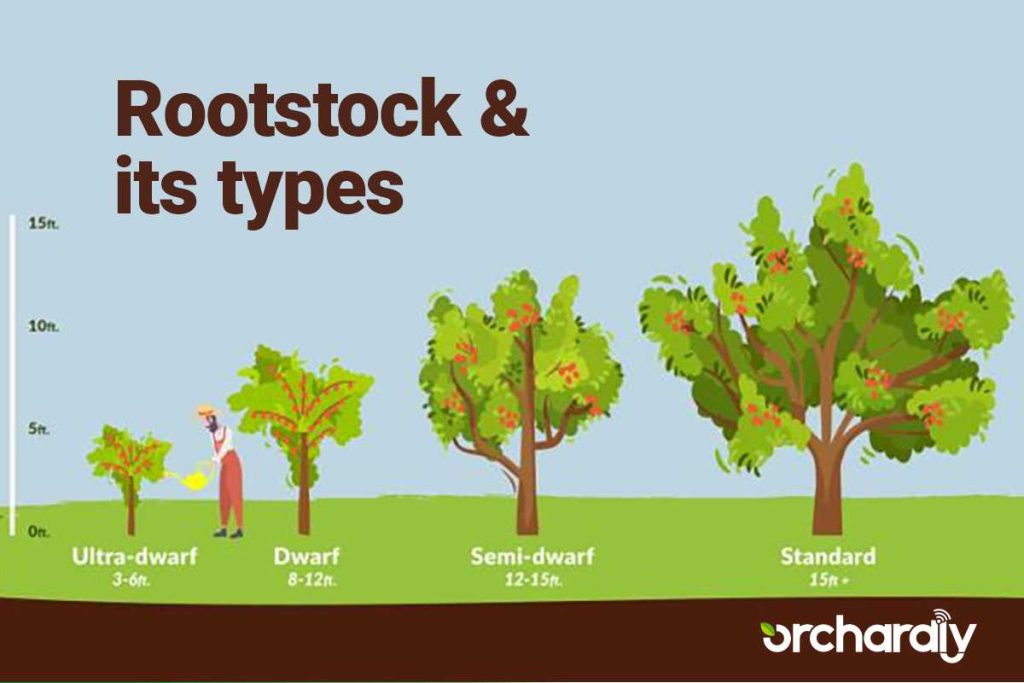Many a time, you’d have observed that many fruit trees planted by seed can take three to eight years to start producing fruits. That’s perhaps the long time. For this reason, there are various scientific innovations that have come into existence so that farmers could purchase immediately fruiting trees that are grafted on already established rootstock.
What is rootstock?
Commercial fruit trees usually consist of two parts vis-à-vis SCION (flowering or fruiting part) which makes up most of the tree above the ground and the ROOTSTOCK which consists of the roots and the lower portion of the trunk. Hence, rootstock is the base and root portion of a grafted plant. A scion is grafted onto rootstock in order to create a new plant with superior qualities.
It allows growers to control various aspects of the tree’s growth and performance, ultimately influencing fruit production and quality. Thoughtful selection and utilization of rootstocks enable growers to create the trees according to the unique conditions of their orchards, ultimately promoting the best possible fruit yield and ensuring the sustainability of the orchard.
Importance and function of rootstocks
- One of the most desired characteristics induced by the rootstock is reduction in scion vigor, or ‘dwarfing’. This characteristic leads to a smaller tree size, by decreasing tree volume, height, canopy diameter and circumference.
- The advantage of the dwarfing effect of rootstocks reduces the need for extensive pruning in commercial orchards, making orchard management more efficient and cost-effective.
- Rootstocks play a key role in inducing precocity or early bearing in apple trees. Early fruit production can significantly impact the economic returns of the orchard and enhance early profitability for growers.
- Rootstocks are selected in part for traits inherent to their root system. One crucial aspect is resistance to specific insect-pests and diseases, thereby improving fruit quality; an important attribute for promoting a healthier and more productive orchard.
- Rootstocks also provide tolerance to various abiotic stresses such as salinity, drought, and flooding, ensuring the survival of trees in challenging environmental conditions.
Apple Rootstock Selection
Apple growers need to carefully consider several factors when selecting rootstocks for their orchards. These considerations are essential for optimizing tree growth, fruit production, and long-term orchard success. These include:
- Soil Type: Different rootstocks have preferences for specific soil types (e.g., sandy, loamy, clay). Growers need to choose a rootstock that thrives in the orchard’s particular soil conditions to ensure optimal nutrient uptake and growth.
- Drainage: Choose a rootstock that matches the orchard’s drainage conditions.
- Climate: Rootstocks should be selected based on the orchard’s geographical location and climate, including factors such as temperature range, frost occurrence, and precipitation. Some rootstocks are better suited to specific climates.
- Disease and Pest Resistance: Select a rootstock that offers resistance or tolerance against several pests and diseases. This minimizes the need for chemical intervention and ensures healthier trees.
- Tree Vigor: Assess the vigor of the rootstock to match the desired tree size. Select a rootstock that aligns with the orchard’s management goals, like, semi-dwarf, or dwarf size to control tree growth and ease of management.
- Scion-Rootstock Compatibility: Ensure the chosen rootstock is compatible with the desired scion varieties. A compatible pairing ensures successful grafting and a successful union between the scion and rootstock.
- Orchard Management: Choose a rootstock that facilitates ease of management and minimizes labor-intensive tasks such as pruning and harvesting.
The scion and rootstock must be of closely related species in order for the graft to be successful. For example, fruit trees like cherry and plum could be a rootstock and scion for each other but an apple fruit tree cannot be used as rootstock for cherry scion and vice versa. The selection of rootstock doesn’t only depend on their close relation to the desired plant but also on the traits that it would impart in the desired plant. There are more scion varieties available than rootstock varieties. So, grafters usually look for naturally growing trees, naturally occurring plant mutation or genetically bred plants to use as rootstock. Once a successful rootstock is identified, it then propagated asexually to create clones of it for use as future rootstock.
Why do we use rootstock?
Rootstocks are mostly used to create very specific plant traits. Rootstocks determine the longevity of the plant, resistance to pests and diseases, cold hardiness, fruit yield, and the size of the tree, its root system and the tree’s ability to adapt to soil types. Also, fruit trees grown from rootstock tend to produce trees that immediately fruit, rather than the 3-8 years it takes to get fruit from a tree grown from seed. Larger fruit trees are grafted to dwarf fruit tree rootstock to create dwarf or semi-dwarf varieties which are easier to grow, and allow growers to grow more trees per acre with an immediate fruit harvest, hence, producing more fruit per acre.
Whilst most scientific attention has focused on developing rootstocks for apple trees, rootstocks are also important for growing other fruit trees like pears, plums, cherries etc. High land values and increases in all other farming costs make it imperative that apples be produced economically and an early return on the investment be realized. The use of appropriate apple rootstocks has greatly improved the economics of growing apples. Depending on which rootstock is used, apple trees may be broadly classified into 3 categories: STANDARD, DWARF AND SEMI DWARF.

Standard
That huge old apple tree in the traditional orchards you see is a standard. These trees can grow 25’ or more if left un-pruned. With good pruning, standard size trees can be planted at about 26 feet x 20 feet with 84 trees per acre; these trees will attain a height of about 24 feet. Standards live longer and bear more fruit than dwarf varieties. They are slow to start cropping taking around 5-8 years to come into bearing and costly to prune and pick. They can live 50 years or longer.
Dwarf
Dwarf trees are small trees for small spaces. They are easy to prune and harvest because they don’t grow as tall. These rootstocks are very precocious and high yielding. Most dwarfs begin bearing fruit in 3-5 years. Dwarfing rootstocks have a limited root volume and benefit from supplemental irrigation in dry seasons and in droughty soils. Dwarfing rootstocks also benefit from total tree support for the life of the orchard.
Semi Drawf
Semi-Dwarf trees are somewhere in between the other two. They can range from 10-16’ tall and need timely pruning to keep them in shape. They are considered very productive. Their fruits are the same size as standards. Fruit bearing generally begins in 3-5 years and can live up to 60 years.
Types of rootstocks based on tree vigor
- Seedling rootstocks: These are the stocks that are grown from seeds; obtained from the fruits of mature apple trees. When apple seeds are sown, the resulting seedlings have diverse characteristics, exhibit robust growth and lack uniformity in their size. Seeds should be collected from the varieties which produces considerable number of plump and viable seeds and produces vigorous and sturdy seedlings like crab apple (Malus baccata), Maharaji (White Dotted Red) and Granny Smith.
- Clonal rootstocks: Refer to rootstocks that are propagated through asexual means; like hard wood cuttings, tissue culture, and layering. For establishing high-density orchards, the ideal choice is clonal rootstocks; favoring size-control, early bearing, have uniform growth, and show resistance to specific insect pests and diseases etc. The clonal rootstocks are commercially multiplied through mound or stool layering.
Some Apple Rootstocks for vigor control and precocity
Small (Dwarf)
M-9 (Malling-9): Most widely used dwarfing rootstock, making it suitable for the orchards with limited available space and can be used as interstock. The tree on this stock reaches a height of approximately 2.5 meters. It requires mechanical support (staking) and assured irrigation due to poor anchorage and shallow rootsystem. It starts bearing fruit within 2-4 years post-planting. It should be planted on a well-drained. Resistant to collar rot but susceptible to wooly apple aphids and fire blight. Readily forms burr knots and is prone to suckering.
M-9 T337: It is an enhanced clone of the M-9 rootstock and can be easily propagated than and produces less burr knots when compared to M-9 and is also resistant to collar rot. It requires a support system.
Geneva 16 (G.16): Trees on this rootstock are approximately 20% and 60% smaller than those on the M-9 T337 and M-26. Precocity and yield efficiency is similar or slightly better than M-9. This rootstock seems to encourage broader branch angles in the scion cultivar. It exhibits resistance to fire blight and shows tolerance to crown and root rot. However, it is susceptible to woolly apple aphid infestations and powdery mildew. Geneva 16 is very sensitive to latent viruses and should only be propagated with virus free scion wood on top.
Geneva 11 (G.11): Vigor and yield is approximately similar to M.26, being resistant to fire blight and collar rot as well as only rarely producing suckers or burr knots and adapts well on most of the soil types. It is moderately susceptible to wooly apple aphid.
Budagovsky 9 (B.9 or Bud9): Trees on this stock are 25 to 35 percent smaller than M.9EMLA depending on the cultivar and need to be supported. It is very cold hardy in nature and shows resistance to collar rot and adapted to well-drained soils.
Medium (Semi-dwarf)
Malling 7 (M.7): This rootstock produces a semi dwarf tree that is freestanding. In rocky, steep, or shallow soils, it tends to lean and deeper planting will help to overcome this problem. Tree on this rootstock attains a height of 3-4 meters and takes 3-5 years to bears fruits. It is well adapted for all soil types including; high temperatures and soil moisture levels but suckers profusely. It is resistant to fire blight, moderate resistant to collar rot, but susceptible to crown gall and wooly aphid.
Large (Semi vigorous)
Malling-Merton 106 (MM.106): This rootstock has a semi-vigourous growth habit, reaching a height of 3- 4 meters. It starts bearing fruit within 3-5 years after planting. Trees are well anchored, no need for support and do not sucker. Susceptible to collar rot and fire blight but shows moderate resistance against wooly apple aphids. This rootstock does not perform well in heavy wet soils. Delicious on MM.106 is susceptible to apple union necrosis.
Very Large (Vigorous)
MM-111: Trees on this rootstock attains a height of 4.5- 6 meters and comes into bearing 5-7 years after planting. Well adapted to all soil types particularly to drought. Trees on this rootstock are well anchored and does not sucker readily. Shows resistant to collar rot and wooly aphid, but susceptible to fire blight.
Interstems: It consists of an understock such as seedling, MM.111 or MM.106, onto which an intermediate stem piece of M.9 or M.27 is grafted. The variety is budded or grafted onto M.9 or M.27 and tree size is directly related to the length of the intermediate stem used. Interstem apple trees offer a strong root system while reducing the size of the overall tree.
Conclusion
Rootstocks play a crucial role in apple tree cultivation, influencing growth, productivity, and sustainability. Thoughtful selection of rootstocks specified to specific soil, climate, disease resistance, and orchard management conditions allows growers to optimize fruit yield and manage orchards effectively. Clonal rootstocks, particularly suitable for high-density orchards, offer desired characteristics, enabling growers to make their orchards according to specific needs and conditions. Overall, the thoughtful selection and utilization of rootstocks are vital for shaping apple trees and ensuring the enduring success and productivity of orchards.


